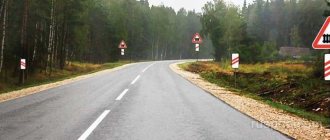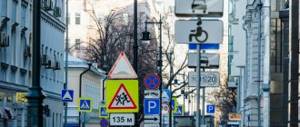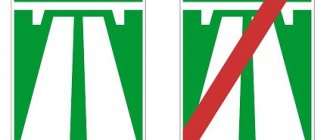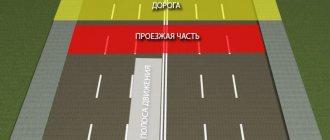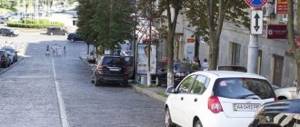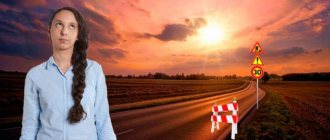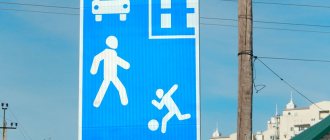Good afternoon, dear reader.
In this article we will again talk about warning road signs that can be installed on the roads of the Russian Federation:
- intersection with a bicycle or pedestrian path;
- Men at work;
- cattle drive;
- wild animals;
- falling stones;
- cross wind;
- low flying aircraft;
- tunnel;
- congestion;
- other hazards;
- direction of rotation;
- intersection section.
Let me remind you that in previous articles in the “Traffic Signs” series, road signs 1.1-1.23 were already discussed:
Warning signs part 1Warning signs part 2
I would also like to remind you that warning signs are installed in a populated area at a distance of 50-100 meters from the beginning of a dangerous section of the road, and outside a populated area - at a distance of 150-300 meters.
Intersection with a bicycle or pedestrian path
This sign warns the driver that in the near future there will be an intersection on the road with a bicycle or combined bicycle-pedestrian path outside the intersection:
Note. According to traffic regulations, cyclists must give way to cars at such an intersection, but in practice they may not do this. Therefore, if you are driving a car, then it makes sense to slow down and let a child who does not know the traffic rules pass. Otherwise, you will have to spend several hours filing an accident.
Traffic rules for cyclists
Road sign "Food, beer and fun"
This sign will bring positive emotions to the driver. It depicts a cheerful woman with a boy. They hint to car enthusiasts the opportunity to try delicious dishes, drink a few glasses of beer, and then go out onto the football field and kick a ball.
What do you think about such original road signs? Have you ever seen something like this on the roads? Write comments and follow our news. Read the first part of the review here.
Men at work
A road work sign (popularly known as road repair) is used to warn the driver about approaching a section of the road where people and specialized equipment are working on the roadway:
The road work sign can be installed both directly during the repair of the roadway (for example, when laying asphalt), and during various works next to the road (for example, when sawing trees):
The road works sign also has one more feature. This sign is repeated both outside populated areas and on their territory. In this case, outside populated areas, a repeat sign is installed at a distance of 50 meters from the dangerous area, and in populated areas directly at the beginning of the dangerous area.
In addition, the road work sign can be installed at a distance of 10-15 meters from the work site if the work is short-term.
Please note that if you see a road works sign ahead, immediately assume that the road works will happen very soon (in 10-15 meters) and try not to hit the road workers.
About wildlife accidents and lawsuits
Road accidents involving wild animals on the road are very common. Every year, more than a hundred moose and up to a dozen wild boars and bears die on the roads of our region. In addition, it is clear that official statistics do not know about all cases of such collisions. Well, people and their cars suffer along with animals. The desire of victims to compensate for the damage incurred in connection with such an accident is understandable. Some of this damage is reimbursed by the auto insurance company. Those who prudently insured life, health and the full cost of the car will also receive compensation. However, there are not many prudent ones, and the auto insurance often does not cover the damage to the vehicle in full.
So people go to court to try to fully compensate for the damage. But I must say right away that they are going there in vain, wasting time, effort and money. I have not been able to find a single court decision that would side with the victims.
In all cases, court decisions contain one compelling argument: the driver must choose a safe driving speed within the permitted maximum speed. If there was a collision with an animal, it means that the driver did not choose that speed. Here is this passage from the decision of one of the courts:
“Clause 10.3. The traffic rules determine the permitted speed of a vehicle outside a populated area on roads - 90 km/h. This speed is the maximum permitted speed, which can only occur under ideal driving conditions (evenness of the surface, visibility of the road conditions, etc.). Part 1 of clause 10.1 of the Traffic Rules specifically stipulates that when choosing a speed in specific road conditions, the driver, in addition to the established speed limit (no more than 90 km/h), must also take into account traffic intensity, road and meteorological conditions, including in particular, visibility in the direction of movement, and the speed chosen by him must be determined taking into account all these conditions. According to paragraph 1.5 of the Traffic Rules, road users must act in such a way as not to create a danger to traffic or cause harm.”
Moreover, this choice does not depend on the presence or absence of the “Wild Animals” sign.
“The section of the road... passes through a natural environment (forest), the inhabitant of which, among other things, is elk. The fact that moose and other wild animals live in forests is generally known and cannot be proven by virtue of Part 1 of Article 61 of the Civil Procedure Code of the Russian Federation. It is also common knowledge that it is impossible to track and control the movement of wild animals in the natural environment. The relevant organizations only note the most populated habitats of wild animals, the most traditional routes of their migration. It is impossible to prevent the appearance of a wild animal in one place or another, including on a specific section of the roadway, and is not within the competence of these organizations” (meaning road workers).
“Road sign 1.27 “Wild Animals” can only warn about approaching a place, that is, a forest area in which wild animals can live. The presence of this sign does not mean, in itself, that a wild animal will definitely appear on the road, and equally, the absence of this sign does not mean that the likelihood of a wild animal appearing on the roadway is excluded.”
It does not affect the result in any way if the plaintiff tries to prove that the road services do not fulfill their obligations to clear the road right of way from trees and shrubs.
The argument will be the same: seeing that the lane is not cleared, the driver must reduce speed enough to prevent a collision.
Here it may seem that the opportunity to blame someone arises if the car was stationary at the time of the collision. But this is also impossible, since there are no persons responsible for the movement of wild animals. Thus, in some cases, plaintiffs try to accuse the hunting department of not properly regulating the number of wild animals in the roadside area.
However, this cannot give any result.
As noted in the materials of one of the cases, “the number of moose in the region is regulated taking into account scientifically based standards.”
The Department can provide information that it issues permits to regulate the number of moose, and the scope of this regulation, according to existing rules, has been agreed upon with scientific organizations. Or, on the contrary, scientific organizations rejected the need for such regulation. Therefore, the plaintiff has no chance of proving that the regulation is not being implemented properly. In addition, as I already wrote in one of the articles, this regulation does not make any practical sense at all. To ensure that the department is not at fault, it is enough to provide at least scientific data on the length of the daily movement of this animal.
And most importantly, the court once again emphasizes that “the specified circumstance (failure of the department to perform the regulatory function) is not in a causal connection with the traffic accident, which arose as a result of the driver’s failure to comply with the Traffic Rules.”
So there is no chance to prove that the accident that occurred was the result of actions (inactions) of any government authorities or organizations. Choose a safe driving speed!
As an afterword, I would advise everyone to pay attention to the time of day at which most accidents occur. This time is clearly recorded in accident reports and court decisions. Elk feed and move mainly (if not spooked) during evening and morning twilight. When it became completely dark at night, he lay down and rested. Exactly the same thing in the morning. He begins to move with the first signs of light. Therefore, the most dangerous time for a collision is the evening morning twilight. If you are on a long journey, drive very carefully until it gets completely dark. Then, in complete darkness, you can add more. The same thing happens in the morning. This applies equally to any season, only at the beginning of summer these two periods are longer and almost merge into one, and in winter they are pronounced.
But still.
And if you still cling to the slightest opportunity for compensation for damage, then, in my opinion, it should be reasoned like this. Who is responsible for determining safe driving speeds and installing appropriate signs? Why is such a restriction established in populated areas, but not outside populated areas in forested areas? Why do they only put up a “Wild Animals” warning sign and not a speed limit sign? Let’s abolish all speed limit signs in the city and apply the same general rule that the court applies to participants in road accidents - the driver chooses a safe speed taking into account the road situation. And if there is a collision with a person at the crossing - well, you didn’t choose the right speed!?
The services responsible for determining a safe speed must establish such a speed with a prescriptive or recommendatory sign. Then, in case of exceeding this speed, the violating driver is responsible, and in the event of a collision that occurred at the permitted speed, the organization that set this speed is responsible.
It is from this service that did not set the proper and safe speed that damages must be recovered. What kind of organization or service is this?
And here is a link to the Federal Law of December 10, 1995 N 196-FZ (as amended on July 13, 2015) “On Road Safety”
Article 21. Measures to organize traffic
Measures to organize road traffic, including the creation and maintenance of the functioning of parking lots (parking spaces) within the boundaries of populated areas, are carried out in order to increase road safety and road capacity by federal executive authorities, executive authorities of constituent entities of the Russian Federation and local government bodies, legal and individuals who are owners or other owners of highways.
This service is the Government of the Russian Federation, the regional administration or local government, depending on whose jurisdiction the road is located. Depending on which owner’s road the accident occurred on, that’s what the lawsuit is about.
In general, this is logical - authorities are responsible for wild animals, their safe population density, and for establishing rules for driving on roads where these animals can cause harm to people. Maybe, after paying for the damage several times, they will think about fencing, crossings for wild animals, etc. They are capable of installing road signs that establish parking rules, but they are not enough to install signs that ensure the safe operation of the road. Why didn’t these organizations put up speed limit signs to ensure road safety? What, they didn’t know (this is common knowledge) that an animal could come out onto the road at night?
Cattle drive
The livestock driving road sign is installed on sections of the road near which livestock farms are located, as well as in those places where livestock is often driven across the roadway:
This sign is typical for rural areas, but in cities it is extremely rare to find it.
If there is such a sign, it makes sense to slow down and be extremely careful, because pets can appear in the most unexpected places.
For example, I happened to see how several cows from the herd lay down to rest right on the roadway just around the bend.
Actions in case of collision
Algorithm of actions in case of a collision with a wild animal:
- Record the location of the killed animal and ensure that other road users do not run into it.
- The wounded animal must be moved to the side of the road. If he shows aggression, then it is better to leave him on the roadway and protect him with signs. To provide assistance, you can contact the Ministry of Emergency Situations or the veterinary service.
- Stay at the scene of the accident and call the traffic police. The inspector who arrives at the scene will independently contact the huntsman or a hunting staff member.
- After drawing up an accident report, all documents on it must be submitted to the insurance company.
If the driver leaves the scene of an accident without permission, the driver faces increased liability (up to and including deprivation of his license) and refusal to pay compensation from the insurance company.
It is prohibited to take the carcass of a killed animal with you. Such actions will lead to a fine of 200,000 rubles or restriction of freedom for six months (Article 258 of the Criminal Code of the Russian Federation “Illegal hunting”).
Wild animals
The wild animals road sign (popularly known as the deer sign) is installed on sections of the road where wild animals may appear:
Please note that a collision with a large wild animal can cause much more harm to the driver and his car than to the animal itself.
In addition, if the animal dies, the driver will have to reimburse its cost to the state. Moreover, the amount can be quite serious:
Liability for hitting an animal
So if you come across a “Wild Animals” sign on the road, be careful. As, indeed, with any other warning road sign.
How best to try to avoid a collision or minimize damage
The first thing a driver should do when noticing an animal on or near the road is to slow down. At the same time, it is important not to brake sharply and make sure that there is no car behind you. If the choice is between saving the life of the animal and avoiding a collision with a multi-ton truck behind you, then it is better not to brake at all.
The lower the speed of the vehicle, the greater the likelihood that the animal will have time to leave the roadway. At minimum speed, you can try to drive around a forest dweller on the side of the road. It is important to first make sure that there is no interference from other road users and eliminate the possibility of skidding. It is forbidden to leave the car in order to drive away a forest dweller. It can be aggressive and will try to attack the driver.
Other recommendations to help avoid a collision or minimize its damage:
- watch the road carefully. The sooner the driver manages to notice the wild animal, the greater the likelihood of successfully passing it;
- use high beams correctly. Its activation is required when driving outside populated areas and in the absence of oncoming traffic. In fog, heavy rain or snowfall, high beams may impair visibility; in this case, it is better to use fog lights;
- choose your travel time. If the path runs through the territory of a nature reserve or wildlife sanctuary, then it is better to refuse to continue driving in the dark. Particularly dangerous periods are considered to be the period of sunset and dawn; at this time, wild animals are most active;
- pay attention to the landscape. Frequent places where animals come onto the road are areas bordering a forest belt or a reservoir. When driving past them, you should concentrate on the road as much as possible;
- pay attention to the signs. You should not ignore the “Wild Animals” sign; it is installed only in potentially dangerous places and is designed to alert drivers;
- realistically assess your capabilities. Most often, those drivers who get into accidents are those who believe that they can quickly react to the appearance of a forest dweller and have time to go around it. But the behavior of the animal is too unpredictable, and its movements are sharp and impetuous. It is almost impossible to predict the further development of events and the trajectory of its movement;
- use passenger assistance. A person sitting in the passenger seat will help to inspect the roadsides more carefully and identify in advance the presence of a wild animal there. At night, the animal’s eyes reflect the light of headlights and are visible in the dark even from a distance. If two red dots are visible on the side of the road, this is a signal for the driver to slow down and slow down;
- Do not reduce your concentration after the first meeting. Wild animals rarely walk alone; more often than not, they gather in packs. If one of the animals was met on the road, then there is a high probability of finding its relatives as you continue driving;
- do not lose vigilance inside populated areas. An animal can get lost and it will be possible to meet it even in a metropolis;
- don't scare the animal. Use the horn or flash the headlights only after the vehicle has come to a complete stop. Otherwise, there is a high probability of scaring a forest dweller, which will lead to him running along the road;
- minimize the consequences of a collision. If an accident is inevitable, then it is worth driving the car in the opposite direction from where the animal is running. It is unlikely that it will have time to bounce back a long distance. It is worth calculating the blow so that it hits a tangent.
Congestion
A traffic sign (popularly known as a traffic jam sign) indicates a section of the road where a traffic jam has formed:
Naturally, this sign should not be installed before the start of the traffic jam itself, but in front of the intersection from which it is possible to bypass the traffic jam. Therefore, the sign is designed either as a temporary sign or as a sign with a variable image (screen).
Well, since in practice traffic jams during rush hours occur simultaneously on all central streets of cities, this sign is used quite rarely.
Other hazards
The other hazards road sign warns that there may be some dangers on the road that cannot be described by other warning signs:
If there is a sign on the road for other dangers, the driver should expect anything.
Note. If you come across a car with an other hazards sign on the rear window (not to be confused with the novice driver sign), then you should stay away from it. Such a driver warns others in advance that he does not know the rules of the road.
Amount of fine for hitting an animal
The legislation regulates liability for downed elk, in accordance with Order of the Ministry of Natural Resources and Ecology of the Russian Federation No. 948 of December 8, 2011, which regulates the amount of damage caused to hunting grounds. According to the resolution, the fine for a downed moose in 2021 is 80,000 thousand rubles. This figure may change depending on various factors: for example, if a female moose is involved in an accident, and moreover, she is expecting offspring.
If traffic police officers determine that at the time of the collision the driver of the vehicle was not complying with the speed limit, then the culprit of the accident will be fined in the amount of 500 rubles for disregarding the signs installed on the road.
How to pay a fine
As a rule, fines for downed animals are imposed immediately after an accident occurs, if no controversial issues arise. Traffic police officers, together with a representative of the hunting industry, draw up an act in which they indicate the amount of the fine for the offense committed.
The fine can be paid in two ways:
- at the nearest traffic police department, for this you need to provide a copy of the protocol and an extract of the fine;
- on the website www.gosuslugi.ru or through any payment system.
The fine must be paid within 60 days from the date the resolution comes into force. Thus, the total period for debt repayment is 70 days.
When can you challenge a fine?
In 2021, you can challenge the amount of liability for a downed animal. The person at fault for the accident is given the opportunity to appeal the decision to impose a fine within 10 days. To do this, you need to provide evidence that mitigates guilt:
- conditions of poor visibility or darkness;
- the driver's attempts to avoid a collision;
- the collision occurred in a place where sign 1.27 was not installed.
Turning direction
The turn direction sign is one of the few warning signs that is designed as a rectangle rather than a triangle:
Such a sign is installed directly at the turn (and not 50-300 meters before it, like many warning signs).
Please note that if there is such a sign, movement is only possible in those directions that are on the sign.
At the same time, the sign itself does not prohibit turning in a different direction, but it says that there is simply no road in the other direction.
Will OSAGO pay for a downed moose?
But a very substantial fine for a downed moose should bother you much less, because such damage is covered by compulsory motor insurance. The maximum loss in this case for you is a reduction in the discount for accident-free driving in the next insurance period. The maximum payment under compulsory motor liability insurance is 400 thousand rubles, therefore, the insurance amount can cover up to 5 downed moose in one (each) road accident.
This conclusion follows from the very first article of the Federal Law “On Compulsory Motor Liability Insurance”, which regulates the definition of an insured event, as well as from the definition of an accident from the Traffic Rules.
Something else useful for you:
- Can a driver's license be revoked for speeding? For what, according to cameras and how to get a fine?
- Road speed signs on a blue background: what are the limits and the permitted speed?
- Road sign “Parking prohibited” according to traffic regulations: what is the coverage area, where and who can park?

